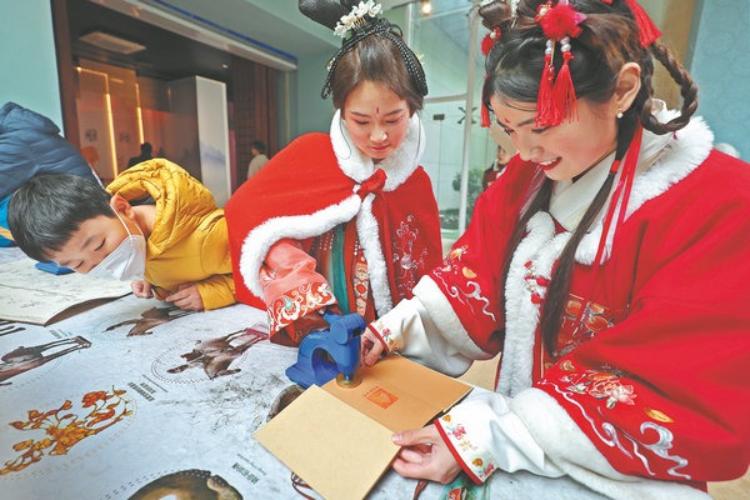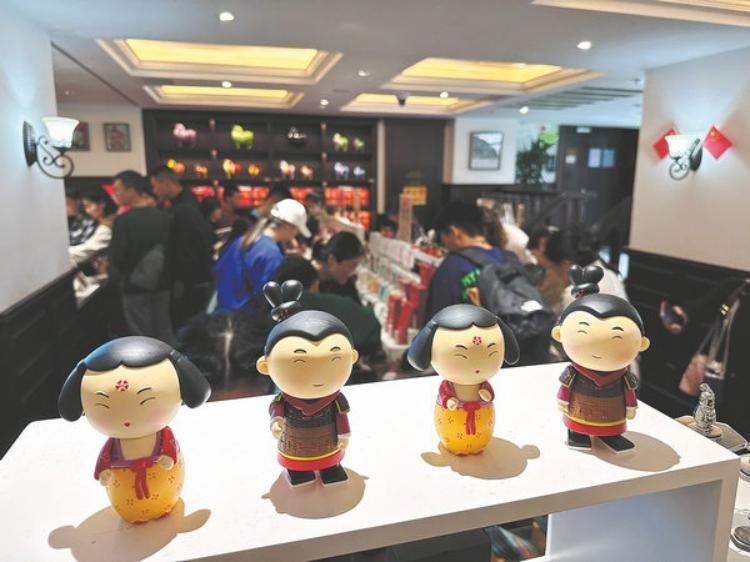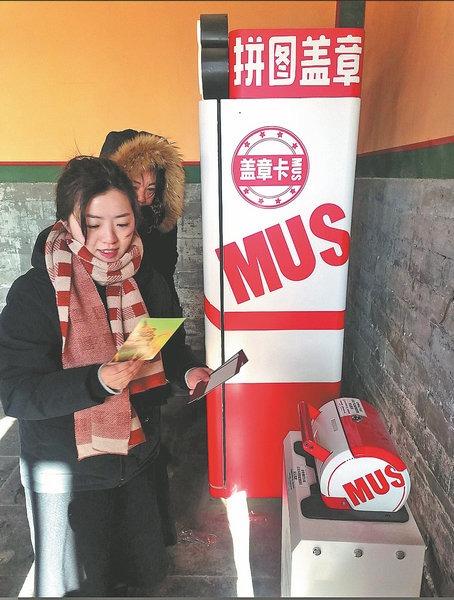 Visitors dressed in hanfu, or traditional Han Chinese costume, collect stamps at a special exhibition about the Tang Dynasty (618-907) at Xi'an Museum in Xi'an, Shaanxi province, in February 2023. (PROVIDED TO CHINA DAILY)
Visitors dressed in hanfu, or traditional Han Chinese costume, collect stamps at a special exhibition about the Tang Dynasty (618-907) at Xi'an Museum in Xi'an, Shaanxi province, in February 2023. (PROVIDED TO CHINA DAILY)
Stamp collecting has recently emerged as a fresh and innovative approach for young people to document their travels, and many have been driven by the hobby, which offers a strong sense of interactivity and ceremony, to explore more attractions.
Instead of merely capturing photos with famous landmarks, enthusiasts of this new trend eagerly explore every nook and cranny of various attractions, museums, and shops during their journeys in search of a diverse array of stamps.
They imprint the stamps, usually with single or multicolored pictures of the scenic spots, names of the places, profiles of famous people or cultural relics, on postcards or in travel journals or commemorative albums, thereby creating a unique keepsake of their travels.
Free or paid, each stamp serves as a tangible representation of the visitor's presence at that specific location, becoming a cherished part of their memories. Furthermore, it has facilitated the discovery of hidden gems and unique travel experiences at destinations.
In the process of searching for these stamps, I toured almost the entire scenic area. I don't usually pay much attention to buildings, but these stamps have made me focus more on their architectural facades.
Shi Junchu, Yunnan
Kuang Zhaoxin, a 25-year-old designer, is an avid traveler and has been passionate about scrap-booking for over six years. She enjoys sketching and painting, using the book as a means to record memories from her travels.
Early last year, during one of her trips, she encountered stamp collecting and decided to incorporate it into her travel journal. Before each trip, she researches stamp-collection strategies on social media. During a two-day trip to Beijing, she collected over 80 stamps.
Kuang particularly admires the beautifully crafted replica artifact stamps found in museums. She said that impressing these into her journal and then recording memories from the museums creates a strong sense of connection.
"It actually leaves a trace, a sense of ceremony. It serves as a great way to record the trip. When you see a particular exhibit and then happen to collect a stamp of the exhibit, looking back, you'll marvel at how beautiful it was and recall how impressive the exhibit was," she said.
Kuang also enjoys purchasing postcards, impressing them with distinctive local stamps, adding well-wishes, and then sending them to her friends.
While collecting stamps, she said she noticed that the majority of stamp collectors are young women and teenagers, and there is also a social aspect to it, whereby friends exchange the stamps they've collected, creating a form of cultural communication.
According to a travel consumption trend report released last year by Tongcheng Travel, a travel agency based in Jiangsu province, stamp-inspired content has gained significant popularity on various travel platforms since September, sparking a new trend in travel consumption.
During the long vacation over the Mid-Autumn Festival and National Day holidays last year, it ranked as the second most popular travel-related keyword online.
 Figurines are used to decorate a stamp-collecting spot to draw tourists at a Xinhua Bookstore in Xi'an, Shaanxi province. (DENG XIAOWEI / FOR CHINA DAILY)
Figurines are used to decorate a stamp-collecting spot to draw tourists at a Xinhua Bookstore in Xi'an, Shaanxi province. (DENG XIAOWEI / FOR CHINA DAILY)
Attractions and destinations design related activities to engage visitors, such as organizing stamp exchange events and stamp-collecting challenges, thereby attracting more young travelers.
On various online social platforms, users share their stamp-collecting experiences, discussing where to obtain stamps for free, which locations offer the widest variety of stamps, and where collectors can avoid long queues.
Shi Junchu, 29, from Yunnan province, came across stamp collecting three years ago while traveling in Wuhan, Hubei province. She found it to be a better way of commemorating her travels than purchasing souvenirs, so she carries a specially prepared notebook for collecting stamps whenever she travels.
Before planning her travel routes, she checks stamp-collecting strategies on social media and considers whether the activity is feasible for her itinerary. After concluding her travels, she shares her own strategies on social media.
 Visitors impress stamps on a souvenir puzzle at Shenyang Imperial Palace Museum in Shenyang, Liaoning province, in November. (LIU BAOCHENG / FOR CHINA DAILY)
Visitors impress stamps on a souvenir puzzle at Shenyang Imperial Palace Museum in Shenyang, Liaoning province, in November. (LIU BAOCHENG / FOR CHINA DAILY)
She has filled six notebooks with stamps. Some of the intricate and delicate examples require multiple impressions to be pieced together into a bigger picture. She once waited in line for an hour and a half for a particular stamp.
"Stamp collecting has added more meaning to my travels. Flipping through those notebooks feels somewhat like looking at photos. I can recall what happened back then just by turning to a page -what delicious food I had, and what fun experiences I enjoyed," she said.
"This habit has improved my understanding of the historical and cultural aspects of various places, because when I collect stamps, I visit the attractions, some of which I wouldn't have visited in the past. I also delve into the stories behind each stamp," she added.
Shi's favorite set comes from the Yonghe Lama Temple in Beijing, consisting of 16 stamps. Collectors need to visit different halls within the temple to obtain the stamps, and each of the designs corresponds to the architecture of the respective halls.
"In the process of searching for these stamps, I toured almost the entire scenic area. I don't usually pay much attention to buildings, but these stamps have made me focus more on their architectural facades," she recalled.
Introducing stamp services has also become a way for many businesses to attract foot traffic. After stamp-collecting enthusiasts learn about these services on online platforms, they visit the stores, generally requiring a minimum purchase before being able to obtain stamps for "free".
Shi said that when strolling in scenic areas, she prioritizes visiting stores where she can collect stamps.
She currently operates a private museum in Kunming. Since last October, she has also introduced stamp-collecting services to encourage more visitors to explore the museum.
Gong Jian, deputy head of the Wuhan Branch of the China Tourism Academy, told China News Service that stamp-collecting activities in various parts of China are flourishing, enhancing the participation and experiential enjoyment of tourists.
In the era of social media, tourists are keen to share their collecting strategies with others through internet platforms, making offline check-ins and online dissemination an effective way of cultural and tourism promotion, Gong said.
He suggested that, in light of this trend, scenic spots should also strengthen the integration of tourism with culture and education in order to enhance the quality of their products.


